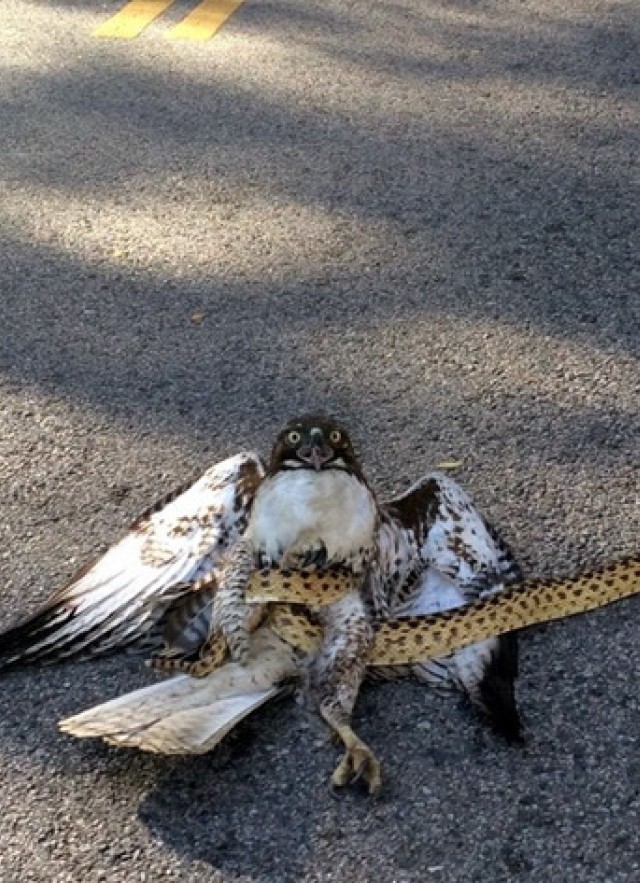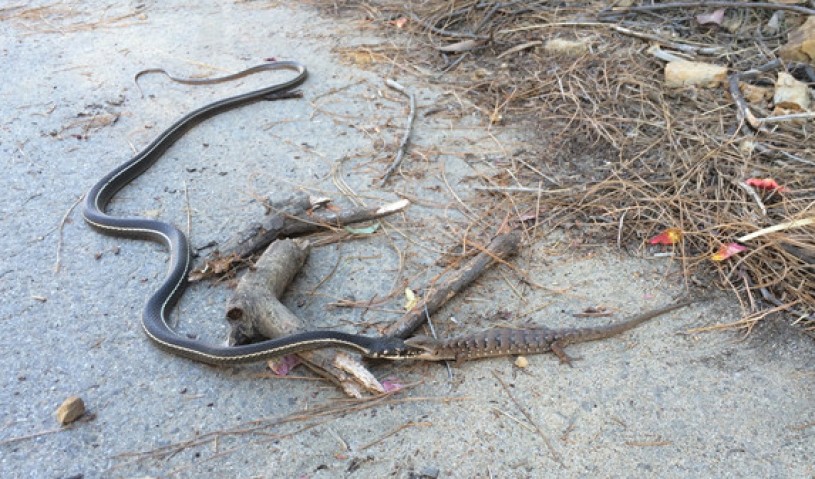Hawk Attacks Snake and Epically Fails!
Guest blog by our very own Dr. Greg Pauly

For local wildlife, living in the big city can be rough. Encounters with people and their dogs, cats, and cars all present threats not experienced by critters living outside of urban areas. Plus, these city dwellers still have to contend with many of the usual threats like predators and weather extremes. Here are two photos celebrating the scrappiness it takes to be a city dwelling reptile, and also celebrating the incredible opportunities to observe urban nature in action.

"David A." sent this photo to theeastsiderla.com of an adult San Diego Gopher Snake, Pituophis catenifer, schooling a juvenile Red-tailed Hawk, Buteo jamaicensis, near Elysian Park.
There are so many cool things going on in this photo. Cool factoid 1: Elysian Park! Smack dab in the middle of Los Angeles, just minutes from downtown, are two big native vertebrates in a life or death struggle.
Cool factoid 2: The where. This photo was taken in the middle of Scott Avenue in Echo Park. Scott Avenue runs through Elysian Park, which this gopher snake likely called home. David stated that the hawk "just came down with the snake in the street."
The likely scenario is that this juvenile hawk spotted the snake and thought it would be a tasty meal. However, while tasty, a snake of this size is not necessarily an easy meal for a young hawk. A big snake means a big defense. Any misplaced grab by the hawk, in which the talons are far back on the snake means that the snake gets multiple loops around the bird to constrict it. This appears to be what is happening here with the gopher snake constricting the hawk's abdomen and apparently pinning back one talon. The defense was enough to impair flight and the pair ended up in the middle of the street. David observed the pair for five minutes, during which time the snake slowly freed itself, and both eventually departed the area.
Cool factoid 3: The when. The photo was taken Friday, December 27. That's right, Winter. Or at least what the calendar tells us is Winter. With our unseasonably warm weather, the temp that day was 82 in Echo Park after multiple days of warm weather and mild evenings. So while the calendar says it is Winter, that doesn't mean our local reptiles are not active.
Cool factoid 4: Added bonus coolness—look closely at the snake's neck. It is dramatically flattening its neck. This is a common, stereotyped defensive display used by gopher snakes and other snakes to look bigger.
Cool factoid 5: there's more! Here's another recent attempted predation event on a reptile, this time by a California Striped Racer, Masticophis (Coluber) lateralis, on a Southern Alligator Lizard, Elgaria multicarinata.

This photo was taken by hiker Rainer Standke on January 22 at Hollywood Reservoir. He gave the photo to Gerry Hans, President of Friends of Griffith Park, who submitted it to the museum's Reptiles and Amphibians of Southern California (RASCals) project. Striped Racers are huge lizard predators and certainly eat a good number of alligator lizards. But it is hard to eat an alligator lizard when the lizard is clamping your jaws shut! We don't know the outcome of this interaction. Maybe the lizard lived, or maybe the snake made a comeback and ended up with a big meal. Again, this is a "wintertime" observation, in which the snake was warm enough to be actively hunting and assured enough of warm temperatures over the next few days to think that it could digest a large lizard meal.
And as with the hawk-gopher snake interaction, this observation was made right here in urbanized areas of Los Angeles.
If you make your own local reptile or amphibian observations, please share them with us by participating in the RASCals project either by visiting the project page or emailing your photo and date and location observed to rascals@nhm.org.
(Posted by: Lila Higgins)